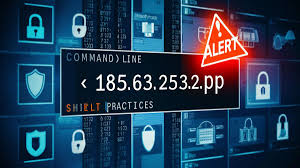Understanding the Significance of “185.63.253.2pp” in Networking and Cybersecurity

In the world of networking and cybersecurity, IP addresses serve as the foundational identifiers for devices connected to the internet. However, encountering an address like “185.63.253.2pp” can raise questions about its validity and purpose. This article delves into the intricacies of such addresses, exploring their potential meanings, implications, and the steps to take when they appear in network logs or configurations.
What Is an IP Address?
An IP (Internet Protocol) address is a unique string of numbers separated by periods (IPv4) or colons (IPv6) that identifies a device on a network. It allows devices to locate and communicate with each other over the internet. For instance, a typical IPv4 address might look like “192.168.1.1”. These addresses are essential for routing data packets between devices and ensuring that information reaches its correct destination.

Decoding “185.63.253.2pp”
The address “185.63.253.2pp” appears to be a malformed or misformatted IP address. The “pp” suffix is not standard in IP addressing and suggests that the address has been altered or corrupted in some way. This could be due to:
- Typographical Errors: Manual entry mistakes during configuration or logging.
- Software Bugs: Issues in network tools or applications that process IP addresses.
- Intentional Obfuscation: Adding characters to mask the original IP address for security or privacy reasons.
It’s important to note that “185.63.253.2pp” is not a valid IP address and cannot be used for network communication.

Possible Origins and Implications
1. Typographical Errors
One of the most common reasons for encountering “185.63.253.2pp” is human error. During manual entry of IP addresses in configuration files, logs, or scripts, an extra “pp” might be inadvertently added. Such errors can lead to misdirected network traffic or failures in establishing connections.
2. Software Bugs
Network management tools or applications that parse and display IP addresses might have bugs that append unintended characters like “pp” to valid addresses. This can occur during data processing or when handling edge cases not anticipated by the software developers.
3. Intentional Obfuscation
In some scenarios, especially in cybersecurity contexts, adding characters like “pp” to an IP address might be a deliberate attempt to obscure the original address. This could be done to:
- Mask the Source: Hide the origin of network traffic to evade detection.
- Bypass Filters: Avoid triggering security filters or firewalls that look for specific IP patterns.
- Protect Privacy: Conceal the identity of a device or user for privacy reasons.
While such obfuscation techniques can be effective, they also complicate network monitoring and troubleshooting efforts.

Steps to Take When Encountering “185.63.253.2pp”
If you come across “185.63.253.2pp” in your network logs or configurations, consider the following steps:
1. Remove the “pp” Suffix
Attempt to remove the “pp” and use the address “185.63.253.2” instead. This might resolve the issue if the “pp” was added due to a typographical error.
2. Verify the Address
Check if “185.63.253.2” is a valid IP address within your network or if it belongs to an external entity. Tools like IP geolocation services can help determine the origin of the address.
3. Investigate the Source
Determine where the malformed address originated. Was it a user input error, a software bug, or an intentional obfuscation? Understanding the source can guide you in preventing future occurrences.
4. Implement Validation Checks
To prevent similar issues in the future, implement validation checks in your network tools and applications. Ensure that IP addresses are correctly formatted and conform to standard conventions.
Also Read: Pizmotidxizvou: Bridging Technology and Culture for a Creative Future
Conclusion
While “185.63.253.2pp” is not a valid IP address, understanding its potential causes and implications is crucial for maintaining a secure and efficient network. By recognizing the signs of malformed addresses and taking appropriate corrective actions, network administrators can ensure the integrity of their systems and prevent potential security risks.



